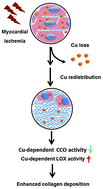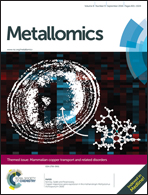Decreased copper concentrations but increased lysyl oxidase activity in ischemic hearts of rhesus monkeys
Abstract
Myocardial ischemia leads to a decrease in copper (Cu) concentrations, along with collagen deposition in which Cu-dependent lysyl oxidase (LOX) catalyzes the cross-linking of collagens leading to tissue stiffness. The present study was undertaken to determine the relationship between decreased Cu concentrations and LOX activities in ischemic hearts of monkeys. Rhesus monkeys were subjected to coronary artery ligation, leading to ischemic infarction. At 8 weeks after the surgery, Cu concentrations and Cu-dependent cytochrome c oxidase (CCO) activities in the infarct area were significantly decreased. Unexpectedly, the Cu-dependent LOX activities in the same area were significantly increased. LOX proteins were accumulated in the cytosol of myofibroblasts, endothelial cells, and residual cardiomyocytes in the infarct area. In contrast, LOX was only found in fibroblasts and myocardial intercalated discs between cardiomyocytes in sham-operated controls. The LOX mRNA level was also increased in the infarct area compared to the sham operated control. This upregulation of LOX was associated with significant increases in collagen deposition; protein levels of type I and III collagens were significantly increased along with increases in their mRNA levels in the infarct area. This finding indicates that under myocardial infarction, Cu-dependent CCO activities were depressed but LOX activities were increased most likely through Cu redistribution although Cu concentrations were significantly depressed.

- This article is part of the themed collection: Mammalian Copper Transport and Related Disorders

 Please wait while we load your content...
Please wait while we load your content...